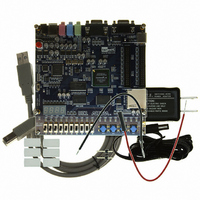P0528 Terasic Technologies Inc, P0528 Datasheet - Page 49

P0528
Manufacturer Part Number
P0528
Description
BOARD DEV DE1 ALTERA
Manufacturer
Terasic Technologies Inc
Type
FPGAr
Datasheet
1.P0528.pdf
(56 pages)
Specifications of P0528
Contents
DE1 Board, Power Supply, USB Cable, Plastic cover and software
For Use With/related Products
Cyclone II 2C20
For Use With
P0033 - BOARD ADAPTER HSMC TO GPIOP0006 - BOARD ADAPTER THDB-SUMP0001 - MODULE DIGITAL CAMERA 5MP (D5M)P0307 - KIT DEV 4.3" LCD TOUCH PANEL
Lead Free Status / RoHS Status
Lead free / RoHS Compliant
Other names
DE1
The Verilog source code for this demonstration is provided in the DE1_Default folder, which also
includes the necessary files for the corresponding Quartus II project. The top-level Verilog file,
called DE1_Default.v, can be used as a template for other projects, because it defines ports that
correspond to all of the user-accessible pins on the Cyclone II FPGA.
5.2 Music Synthesizer Demonstration
This demonstration shows how to implement a Multi-tone Electronic Keyboard using DE1 board
with a PS/2 Keyboard and a speaker. Figure 5.1 shows the setup of the demonstration.
PS/2 Keyboard is used as the piano keyboard for input. The Cyclone II FPGA on the DE1 board
serves as the Music Synthesizer SOC to generate music and tones. The VGA connected to the DE1
board is used to show which key is pressed during the playing of the music.
Figure 5.2 shows the block diagram of the design of the Music Synthesizer. There are four major
blocks in the circuit: DEMO_SOUND, PS2_KEYBOARD, STAFF, and TONE_GENERATOR. The
DEMO_SOUND block stores a demo sound for user to play; PS2_KEYBOARD handles the users’
input from PS/2 keyboard; The STAFF block draws the corresponding keyboard diagram on VGA
monitor when key(s) are pressed. The TONE_GENERATOR is the core of music synthesizer SOC.
User can switch the music source either from PS2_KEYBOAD or the DEMO_SOUND block using
SW9. To repeat the demo sound, users can press KEY1.
The TONE_GENERATOR has two tones: (1) String. (2) Brass, which can be controlled by SW0.
• Power on the DE1 board, with the USB cable connected to the USB Blaster port. If
• You should now be able to observe that the 7-segment displays are displaying a sequence of
• Optionally connect a VGA display to the VGA D-SUB connector. When connected, the
• Optionally connect a powered speaker to the stereo audio-out jack
• Place toggle switch SW9 in the UP position to hear a 1 kHz humming sound from the
necessary (that is, if the default factory configuration of the DE1 board is not currently
stored in EPCS4 device), download the bit stream to the board by using either JTAG or AS
programming
characters, and the red and green LEDs are flashing.
VGA display should show a pattern of colors.
audio-out port. Alternatively, if switch SW9 is DOWN, the microphone-in port can be
connected to a microphone to hear voice sounds, or the line-in port can be used to play audio
from an appropriate sound source.
47
DE1 User Manual























